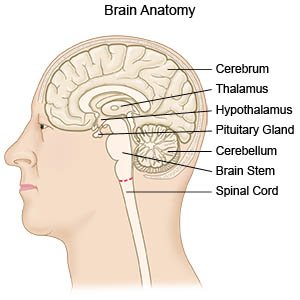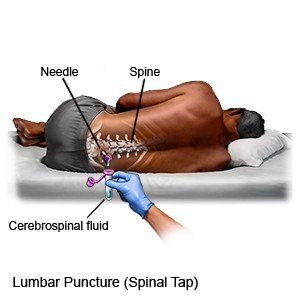Brain Tumors
Medically reviewed by Drugs.com. Last updated on Aug 4, 2025.
What is a brain tumor?
A brain tumor is a mass that grows in your brain, or in an area near the brain. Examples include nerves in your skull, pituitary gland, or the membranes that cover your brain. The tumor may start in your brain or travel to your brain from another part of your body. There are many kinds of brain tumors. Each kind is named for where it begins and what it does in the brain. A tumor may be malignant (cancer), or benign (not cancer). It may grow quickly or slowly.
 |
What causes or increases my risk for a brain tumor?
- A family history of brain tumors
- Older age
- Exposure to radiation
- Certain types of cancer that can spread to the brain, such as breast, lung, or colon cancer
- A weakened immune system
What are the signs and symptoms of a brain tumor?
Signs and symptoms depend on the kind of tumor you have, and where it is in your brain. Brain tumors often cause problems on only one side of the body. Some tumors can cause problems on both sides. You may have any of the following:
- New or different headaches, or headaches that become more frequent or severe
- Speech, hearing, or memory problems
- Nausea or vomiting
- Vision problems, such as blurred or double vision, or hearing loss
- Confusion, personality changes, or seizures
- Areas that are weak or numb in an arm or leg, or loss of balance
- Bladder or bowel control problems
How is a brain tumor diagnosed?
Your healthcare provider will examine you and ask about your symptoms. Tell him or her if you have ever had cancer, and what kind you had. Tell him or her if you have a family history of brain tumors or cancer. You may need any of the following:
- A neurologic exam can show healthcare providers how your brain is working. Other names for this test include neuro signs, neuro checks, or neuro status. Healthcare providers will check how your pupils react to light. They may check your memory and how easily you wake up. Your hand grasp and balance may also be tested.
- X-ray, MRI, or CT pictures may show the size and location of any tumors. You may be given contrast liquid help to help the tumors show up better. Tell the healthcare provider if you have ever had an allergic reaction to contrast liquid. Do not enter the MRI room with any metal. Metal can cause serious injury. Tell the healthcare provider if you have any metal in or on your body.
- A PET scan is used to take pictures of areas in your body. A small amount of radiation, called tracer, is put into your body before the PET scan. The tracer shows how chemicals, such as glucose (sugar), are working in your tissues. A PET scan may show a tumor or if a tumor has spread.
- A biopsy is a procedure used to take a sample of the tumor to be tested. Tests will show if the tumor is benign or malignant, and what kind of tumor it is.
- A lumbar puncture, or spinal tap, is a procedure used to take a sample of spinal cord fluid. The sample is tested for cancer cells in the fluid. This test will be used if other tests show it is a cancer that spreads through spinal fluid.

How is a brain tumor treated?
A tumor that travels to the brain will need treatment for the original kind of cancer. For example, breast cancer that travels to the brain may respond to drugs used to treat breast cancer. One or more of the following may be used to treat the tumor or problems caused by the tumor:
- Medicines may be given to lower your risk for seizures, or to reduce swelling. This may help relieve symptoms such as headaches. Hormone medicine may also be given if a part of the brain that produces hormones is affected. You may also need blood thinners to prevent a blood clot. A brain tumor can increase your risk for blood clots.
- Chemotherapy is medicine to help kill cancer cells. The medicine is usually given through an IV.
- Radiation is used to help treat brain tumors and to prevent new tumors from forming. Radiation can help you maintain your normal daily activities during treatment.
- Surgery may be used to remove the tumor. This is done if the tumor is in an area where surgery can be done safely. During surgery, such as craniotomy, healthcare providers will open your skull and remove the tumor. Surgery is used for both malignant and benign tumors. Any brain tumor can grow into another part of the brain and destroy healthy brain tissue. The goal of surgery is to remove as much of the tumor as possible.
- Radiosurgery targets cancer cells without harming healthy brain tissue. You may need radiosurgery if you have more than one tumor or if you cannot have open surgery, such as a craniotomy.
Treatment options
The following list of medications are related to or used in the treatment of this condition.
Related medications
What can I do to manage my symptoms?
- Ask for support. A brain tumor can change the way you act, think, and feel. Your memory, concentration, and ability to learn may decline. You may act without thinking or become more emotional. Talk with family and friends about these changes and about continuing care, treatments, and home services. Go to all follow-up appointments.
- Rest as needed. You may need more rest than usual, especially after cancer treatment.
- Do not smoke. Nicotine and other chemicals in cigarettes and cigars can cause brain and lung damage. Ask your healthcare provider for information if you currently smoke and need help to quit. E-cigarettes or smokeless tobacco still contain nicotine. Talk to your healthcare provider before you use these products.
- Eat a variety of healthy foods. Healthy foods include fruits, vegetables, whole-grain breads, low-fat dairy products, lean meats, fish, nuts, and cooked beans. Try to eat small meals if you have any nausea. Ask if you need to be on a special diet.

- Be physically active as directed. Physical activity, such as exercise, can increase your energy and help keep your immune system strong. Your healthcare provider can help you create a physical activity plan.

- Go to physical, occupational, or speech therapy as directed. A physical therapist can help you build muscle strength and coordination. An occupational therapist can help you find ways to do your daily activities more easily. A speech therapist can help you if your tumor caused problems with speaking.
Where can I find support and more information?
- American Brain Tumor Association
8550 West Bryn Mawr Avenue, Suite 550
Chicago , IL 60631
Phone: 1- 800 - 886-2282
Web Address: http://www.abta.org
Call your local emergency number (911 in the US) if:
- You have a seizure.
When should I seek immediate care?
- Your arm or leg feels warm, tender, and painful. It may look swollen and red.
- You have new problems walking or moving one side of your body.
- You have new or worsening headaches or body swelling.
When should I call my doctor?
- You have questions or concerns about your condition or care.
Care Agreement
You have the right to help plan your care. Learn about your health condition and how it may be treated. Discuss treatment options with your healthcare providers to decide what care you want to receive. You always have the right to refuse treatment. The above information is an educational aid only. It is not intended as medical advice for individual conditions or treatments. Talk to your doctor, nurse or pharmacist before following any medical regimen to see if it is safe and effective for you.© Copyright Merative 2025 Information is for End User's use only and may not be sold, redistributed or otherwise used for commercial purposes.
Learn more about Brain Tumors
Treatment options
Care guides
Symptoms and treatments
Further information
Always consult your healthcare provider to ensure the information displayed on this page applies to your personal circumstances.
